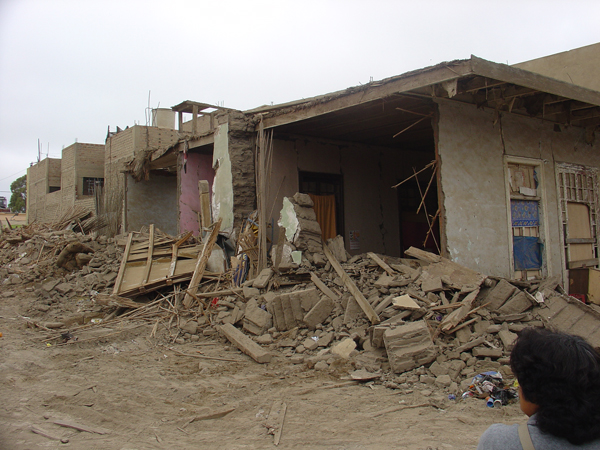Building Paradigms for Recovery:
A Contribution to the Reconstruction Process in Southern Peru

Photo: © UNDP/BCPR/LAC
On August 15, 2007, a seismic event measuring 7.9 occurred in southern Peru. More than 500 lives were lost and over 75,000 homes were destroyed in the departments of Ica, Lima and Huancavelica. The Peruvian government, through the Integral Fund for Reconstruction of the South (FORSUR), estimated that an investment of US$756 million would be required for housing, water, sanitation, health, education, roads and production infrastructure.
Eight months later, an estimated 56,000 families, whose homes were destroyed, are still living in shelters, temporary housing, tents, and with relatives, while their living conditions have been complicated by the deterioration of the “emergency roofs,” insufficient drinking water, the lack of sanitation systems, and their corresponding effects on mental and physical health and on safety. At the same time, government permanent housing programs have found a number of constraints in their implementation, especially due to the existing complexity of the current land tenure system.
Compounding this is the earthquake’s impact on the technical and administrative capacity of local governments, as well as problems for coordinating efforts among the different government levels.
This scenario demonstrates the ongoing importance of appropriate management of a transition to recovery or early recovery, so that people’s immediate and mid-term needs are addressed, as well as the key aspects for an agile and efficient recovery and reconstruction process. With this goal in mind —and with a focus on sustainable human development that emphasizes local capacity building, in accordance with priority one of the Hyogo Framework for Action: “ensure that disaster risk reduction is a national and a local priority” with a solid institutional base for its application— the United Nations Development Program (UNDP), jointly with the UNDP’s Bureau for Crisis Prevention and Recovery (BCPR), has delivered and continues providing technical assistance in the transition/early recovery process at three different levels, namely: (a) At the local level, with FORSUR and the ministries of the relevant sectors as reference points, (b) At the local level, interfacing with regional, provincial and district governments, and (c) At the international level, mainly interacting with the United Nations agencies and donors. There has also been an effort to include NGOs and organized civil groups.
The dynamics created —of close coordination and accompaniment of the government at the national and local levels, and by sector— has enabled UNDP and the BCPR to exercise a high degree of strategic influence at each of these levels and among the donor community, so as to facilitate better decisions and more appropriate actions. This level of influence and advocacy has been, and is, possible due to the strong commitment of the United Nations Resident Coordinator. The following are a few examples of this:
• In conjunction with UN HABITAT, support has been provided to the Ministry of Housing for the development of a national policy framework containing the conceptual, technical and operational guidelines needed to organize in a coherent fashion the transition and reconstruction processes in the field of housing. To support its practical application, projects have been profiled in order to manage government subsidies, design a technical and legal assistance system concerning ownership and construction, and implement a rural housing program.
• Support has been provided to FORSUR, as an agency created by the government, for the incorporation of the transition to recovery/early recovery into its organizational structure, coordination with other government sectors, and deployment to the affected areas.
• Particular emphasis has been placed on support for provincial, regional, and district governments, which have received direct technical assistance for coordination with government agencies and civil society, the planning of transition and reconstruction processes, the design of land use guidelines, the establishment of investment priorities, and the design of different projects.
• In an effort to develop practical criteria for the process, resources have been provided and leveraged for comprehensive attention to vulnerable populations. This entails following a complete transition and recovery process, deploying an array of government and private institutions to find permanent solutions to land, housing, health, education, sanitation, and social issues, while also putting in place temporary solutions for the transition period.
The positive evaluation of this technical assistance has led the Peruvian national government, as well as regional, provincial and district authorities, and civil society organizations to request that this intervention strategy be ongoing at three levels (national, sector-specific, and local), with a solid local capacity-building vision. This requires the continued support from the United Nations to the overall process and approaching it as “a pilot intervention model” for the recovery of the affected areas. Nonetheless, given the current complexities involved in the reconstruction process, the prolonged transition period, the involvement of many different actors, and the deteriorating living conditions of displaced families, the need for ongoing and expanded support is substantial and will require increased technical and financial investments to consolidate what has been started and to provide new value added.
It is important to maintain the focus on local capacity-building, moving from assistance for planning and transition coordination to a more sustained effort for the recovery of productive and institutional capacity, social participation and public administration, based on an adequate legal framework for risk management. At the national level, it is important to continue devoting public policy-making efforts, but it is also necessary to move ahead with the design of programs and tools to put those policies into practice.
Finally, the continued support and commitment of UNDP and the BCPR will help translate this experience in Peru into a “good practice” for recovery assistance. In other words, it would be a practice from which lessons can and should be drawn in terms of knowledge, procedures and recommendations for future interventions in similar situations or in other contexts. It is possible that the future of how technical assistance can and should be provided in recovery processes is in the making in Peru.
|